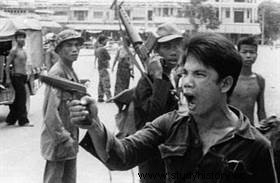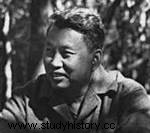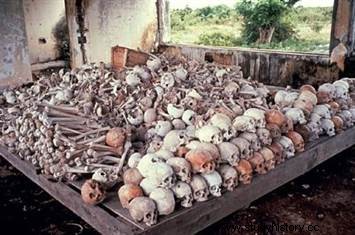 The term Khmer Rouge commonly refers to the Cambodian Communist Party, which came to power in 1975 after the fall of the Republic of Cambodia of dictator Lon Nol. Its leader Pol Pot will build in the months that follow a totalitarian state by systematically eliminating all opposition. Taking the pretext of the American bombardments on the big cities, he will organize the deportation of the urban populations in the campaigns in order to better control them. The Khmer Rouge isolate Cambodia, which turns into a gigantic forced labor camp. Their brutality resulted in the deaths of probably more than two million people.
The term Khmer Rouge commonly refers to the Cambodian Communist Party, which came to power in 1975 after the fall of the Republic of Cambodia of dictator Lon Nol. Its leader Pol Pot will build in the months that follow a totalitarian state by systematically eliminating all opposition. Taking the pretext of the American bombardments on the big cities, he will organize the deportation of the urban populations in the campaigns in order to better control them. The Khmer Rouge isolate Cambodia, which turns into a gigantic forced labor camp. Their brutality resulted in the deaths of probably more than two million people.
The Khmer Rouge
Also known as Angkar Loeu, the supreme organization, the Cambodian Communist Party, founded in the 1950s, remained for a very long time a small party with no real influence ( 4% of the vote in the 1955 elections). Banned in 1958, it remained underground and was reorganized around 1961 by Saloth Sar, better known under the pseudonym of Pol Pot. Described as "Khmer Rouge" by Prince Sihanouk, they attempted to seize power in 1962. This failure was followed in 1966 by a peasant uprising in Samlaut, in the province of Battambang, brutally suppressed by General Lon Nol , the prime minister at the time. The leaders of the legal left then joined the Communist Party. Khieu Samphan, Hou Yuon and Hu Nim joined the ranks of an organization which did not exceed a thousand members, but which knew how to take advantage of the situation created by the Vietnam war. In January 1968, the Communist Party began the armed struggle in the Cardamom Mountains, without any real success.
 Lon Nol's pro-American coup in 1970 led Prince Norodom Sihanouk to form the United National Front of Kampuchea (FUNK). Hanoi immediately supports him and obtains the rallying of the Khmer Rouge to FUNK. On March 23, 1970, Prince Sihanouk's call for resistance, launched from Beijing, swung the peasantry into the FUNK camp. Immediately, the Khmer Rouge, which had no more than 3,000 armed men, recruited massively and could control the countryside. The American intervention in April 1970 did not change the situation. On April 17, 1975, Phnom-Penh, besieged for months by Khmer Rouge peasants, fell.
Lon Nol's pro-American coup in 1970 led Prince Norodom Sihanouk to form the United National Front of Kampuchea (FUNK). Hanoi immediately supports him and obtains the rallying of the Khmer Rouge to FUNK. On March 23, 1970, Prince Sihanouk's call for resistance, launched from Beijing, swung the peasantry into the FUNK camp. Immediately, the Khmer Rouge, which had no more than 3,000 armed men, recruited massively and could control the countryside. The American intervention in April 1970 did not change the situation. On April 17, 1975, Phnom-Penh, besieged for months by Khmer Rouge peasants, fell.
Pol Pot's bloody dictatorship
The Khmer Rouge claiming to be a "creative" Maoism set up a socio-economic system based on the principles of autarky and militarization of communities. The elections in which only the peasants and the members of the Party participate are largely rigged and in reality the power is entirely concentrated in the hands of the Angkar (the Organization in Cambodian):the revolutionary council led by Pol Pot.
Angkar quickly revealed its true face by ordering the execution of all the intellectual elite of the country (liberal professions, academics, military), then by collectivizing the agricultural production of frantic manner. Representatives of a peasant communist organization, the Khmer Rouge then decided to empty the cities and ruralize Cambodia. Industry, all cities and infrastructure are ransacked in the name of building a new people and a new man fully devoted to the community. Money is abolished, families separated and individuals forced to work at a frantic pace in agricultural cooperatives.
 The effects of this policy of totalitarian terror were truly catastrophic. After the deportation, which caused hundreds of thousands of deaths, forced labour, malnutrition and repression caused the death of 1 to 3 million people. This policy of genocide of urban populations and elites will only be revealed following the Vietnamese intervention. The Khmer Rouge will bring about their own downfall by waging a veritable war against the Vietnamese minority in Cambodia, which will lead to the invasion of this country by the Vietnamese army in December 1978. Vietnam indeed decides to settle the question by force and, in three weeks of campaigns, drove out the Khmer Rouge who took refuge in their usual guerrilla zones, the Cardamom Mountains and the Dangrek range, on the Thai border.
The effects of this policy of totalitarian terror were truly catastrophic. After the deportation, which caused hundreds of thousands of deaths, forced labour, malnutrition and repression caused the death of 1 to 3 million people. This policy of genocide of urban populations and elites will only be revealed following the Vietnamese intervention. The Khmer Rouge will bring about their own downfall by waging a veritable war against the Vietnamese minority in Cambodia, which will lead to the invasion of this country by the Vietnamese army in December 1978. Vietnam indeed decides to settle the question by force and, in three weeks of campaigns, drove out the Khmer Rouge who took refuge in their usual guerrilla zones, the Cardamom Mountains and the Dangrek range, on the Thai border.
Fall and trial of the Khmer Rouge
Overthrown in January 1979, Pol Pot and his companions nevertheless continued to lead a hopeless guerrilla war until the end of the 1990s. Harassed by government forces , powerless to reform a united front with the supporters of Norodom Sihanouk, the day after Hun Sen's coup in July 1997, the Khmer Rouge could not prevent the defections from multiplying. Shortly after Pol Pot's death in April 1998, they lost most of their forces and control of the Anlong Veng border area, suffering an unprecedented setback that robbed them of all hope of playing again, at least in near future, a political role of primary importance in Cambodia.
Almost thirty years after the events, an extraordinary tribunal (composed of Cambodian and international judges) begins in Phnom Penh the trial of the main perpetrators (still alive) of the crimes committed between 1975 and 1979 by the Khmer Rouge regime, under which two million people perished. Indicted for genocide, war crimes and crimes against humanity Kang Kek (known as "Douch"), former director of the S-21 security center, Nuon Chea, former political commissar of the army, Khieu Samphan, former head of State, Ieng Sary, former head of diplomacy, and his wife Ieng Thirith, former minister.
Bibliography
- The Khmer Rouge Trial:Thirty Years of Investigation into Francis Deron's Cambodian Genocide. Gallimard 2009.
- Cambodia:history and issues:1945-1985 by Camille Scalabrino. The Harmattan, 2000.
